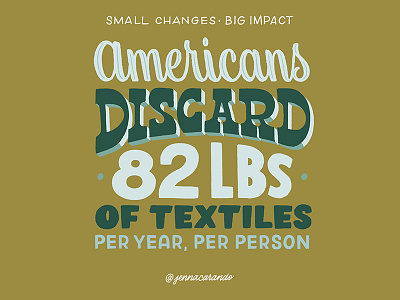Small Changes, Big Impact
Americans discard 14 billion pounds of textiles per year, or about 82 pounds per person. we’re also the largest consumer of new textiles (according to Textile Beat 2016).
🚗💨 the EPA estimates that diverting just clothing from landfills would be the eco-equivalent of taking 7.3 million cars and their attendant CO2 emissions off the road.
you can't talk about fast fashion without mentioning the toll it takes on the environment and on it's workers. 💧 the apparel industry is responsible for 10% of all global carbon emissions and is the second-highest polluter of clean water. ⛽️ most items aren't sold where they're produced, requiring lots of nonrenewable oil to get to consumers. 👟 Americans throw away 300 million pairs of shoes each year, which take thousands of years to break down in a landfill and emit tons of methane. ⚠️ torture, trafficking, slavery, dangerous working conditions (underegulated facilities, chemicals, etc.), and child labor run rampant in fast fashion. 🚨 168 million children — 14% of the world's children — are involved in child labor today. 🙎🏼♀️ the garment sector is composed of 80% women, and less than 2% earn a living wage. if feminism is important to you, embracing slower, ethical fashion is a great way to make an impact.
💪 never underestimate the important role your purchases and feedback play — the fashion industry survives off of consumer demand. what you choose to purchase, or not purchase, can have a major impact.
interested in digging deeper? 🎞 watch “The True Cost” documentary — it may completely shift the way you think about what you wear.
In my next post, we’ll cover cost-effective ways to switch to slow fashion!
(all facts and stats above, unless otherwise noted, are from "Give a Shit" by Ashlee Piper, a book I absolutely devoured this past weekend. she provides citation in her book for all claims.)
follow along on Instagram!









